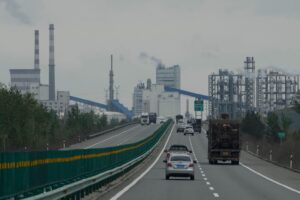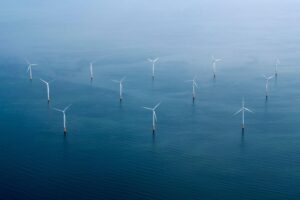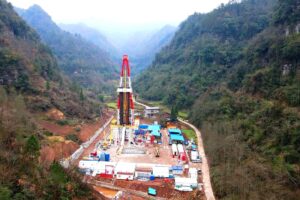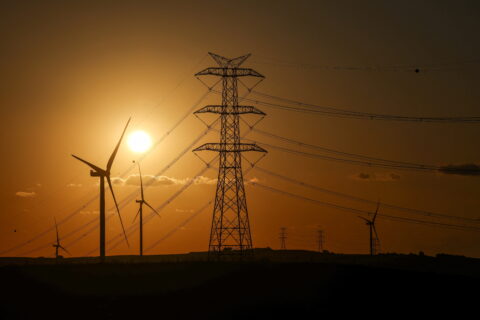China’s carbon dioxide (CO2) emissions stayed at, or just below, last year’s levels in the third quarter of 2024, after a fall in the second quarter.
The new analysis for Carbon Brief, based on official figures and commercial data, leaves open the possibility that China’s emissions could fall this year.
However, recent record-high temperatures caused emissions to go up in September and new government stimulus measures mean there is now greater uncertainty over the country’s emissions trajectory.
Heatwaves through much of August and September caused a major increase in electricity demand for air conditioning, which, combined with weak hydropower output, meant a 2% increase in coal-fired power generation and a 13% rise for gas-fired power in the third quarter, despite wind and solar growth continuing to break records.
The increase in emissions in the power sector was offset by falling emissions from steel, cement and oil use, plus stagnating gas demand outside the power sector, meaning China’s CO2 output in the third quarter was flat or slightly declined, relative to a year earlier.
Other key findings from the analysis include:
- Solar generation rose 44% in the third quarter of the year and wind by 24%, with both continuing to see record-breaking additions of new capacity.
- Hydro generation was up 11% compared with last year’s drought-affected figures, but remained short of expected output. Nuclear power was up 4%.
- Oil demand fell by around 2%, due to falling construction activity, the rise of electric vehicles (EVs) and natural gas (LNG) trucks, as well as weak consumer spending.
- Emissions from steel fell by 3% and cement by 12% in the third quarter, as both sectors continued to see the effect of falling construction activity.
- The coal-to-chemicals industry received renewed political backing and coal consumption in the sector has risen by nearly a fifth in the year to date.
Emissions would need to fall by at least 2% in the last three months of the year, for China’s annual total to drop from 2023 levels. This outcome is supported by the ongoing slowdown in industrial power demand growth and the end of the air-conditioning season.
However, new economic stimulus plans announced in late September with no apparent emphasis on emissions, add uncertainty to this outlook.
In any case, China will remain off track against its 2025 “carbon intensity” target, which requires emissions cuts of at least 2% in 2024 and 2025, after rapid rises in 2020-23.
Looking further ahead, policymakers recently provided new indications of the country’s plans for peaking and reducing emissions, signalling a gradual and cautious approach which falls short of what would be needed to align with the goals of the Paris Agreement.
But, if the country’s rapid clean energy growth is sustained, it has the potential to deliver emission reductions more swiftly.
Clean-energy expansion met all power-demand growth over summer
Defying predictions of slowing growth, China’s electricity demand increased by 7.2% year-on-year in the third quarter of 2024, up from an already rapid 6.9% in the second quarter.
The make-up of growth changed, however. Some 60% of the increase in demand came from the residential and services sectors, with household demand up by a blistering 15%.
Industrial power-demand growth continued to slow down, increasing by 4.6% in July–September, down from 5.9% in the second quarter.
At the same time, solar power generation increased by 44% year-on-year and wind power generation by 24%. Hydropower grew 11%, despite falling short of average utilisation, and nuclear power generation growth was muted at 4% due to few new reactors being commissioned.
The rapid rise of electricity demand outpaced these increases from low-carbon sources, with the gap between demand and rising clean supply being met by a 2% increase in coal-fired power generation and a 13% rise for gas-fired power, as shown in the figure below.
This caused a 3% increase in CO2 emissions from the sector in the third quarter of the year.

However, looking at the whole summer period, whether taken as May-September or June-August, clean-energy expansion covered all of electricity demand growth.
This year, August and September were hotter than last year, resulting in rapid growth in power demand for air conditioning. Last year, in contrast, June and July were hotter.
Thermal power generation from coal and gas fell overall during the summer period, despite the rapid increase in residential power demand, with a 7% drop in June, 5% drop in July, a 4% increase in August and a 9% increase in September. Growth rates during individual months are heavily affected by which months the worst heatwaves fall on.
In terms of newly built generating capacity, solar continued to break last year’s records, with 163 gigawatts (GW) added in the first nine months of 2024. This is equal to the combined total capacity in Germany, Spain, Italy and France, the four EU countries with the most solar capacity. China’s solar capacity additions in the third quarter were up 22% year-on-year, as shown in the figure below.

The growth in China’s solar power output this year alone is likely to equal the total power generation of Australia or Vietnam in 2023, based on growth rates during the first nine months of the year.
Wind power additions accelerated as well, with 38GW added in the year to September, up 10% year-on-year and exceeding the total wind power capacity in the UK of 30GW.
China’s State Council approved 11 new nuclear reactors for construction in one go in August. The total power generating capacity of the approved projects is about 13GW. With 10 reactors approved in both 2022 and 2023 – and now 11 in 2024 – the next batch of nuclear power capacity is getting off the ground and adding to China’s clean-energy growth.
Hydropower capacity only increased 2% year-on-year, implying that most of the 11% third-quarter increase in generation was due to a recovery in capacity utilisation.
In response to severe droughts, utilisation had fallen to its lowest level in more than a decade in 2022, and recovered only partially in 2023, so this year’s recovery was expected and is closer to expected average hydropower generation.
China’s approvals of new coal power plant projects plummeted by 80% in the first half of 2024. Just 9GW of new capacity was approved, down from 52GW in the first half of last year. However, according to the Polaris Network, an energy sector news and data provider, eight large coal power projects were approved in the third quarter, likely representing an uptick in the rate of approvals compared with the first half of the year.
Construction and oil demand slowdown continued to pull down total emissions
While power sector emissions saw a small amount of growth in the third quarter of 2024, the ongoing contraction in construction volumes pulled down total emissions.
As a result, CO2 emissions stayed flat in the third quarter of 2024, at or just below the levels seen in the same period a year earlier, as shown in the figure below.

Digging deeper into the construction-led decline in emissions outside the power sector, steel output fell 9% and cement 12%, as real estate investment contracted 10% in the third quarter, maintaining the same rate as in the first half-year.
This translated into an 11% (24m tonnes of CO2, MtCO2) reduction in CO2 emissions from cement compared with the same period in 2023, shown in the figure below.
Steel emissions only fell by 3% (13MtCO2), despite the 9% fall in steel production. The reason is that the brunt of the drop in demand was borne by electric arc steelmakers rather than the coal-based steel plants with a much higher emission intensity.
The sector lacks the incentive to prioritise electric arc furnaces, which use recycled scrap and have much lower emissions. In theory, this could be encouraged by the inclusion of steel in China’s emissions trading system.
However, if the sector is treated in the same way as power, with separate benchmarks for coal-based and electric steelmaking, it will not create incentives to switch to electricity.
As one step towards structural change in the sector, the industry ministry issued a policy suspending all permitting of new steelmaking capacity, turning a de-facto stop to new permits – observed since the beginning of the year – into a formal moratorium. Until last year, the sector had been investing heavily in new coal-based steel capacity.

The other major area where emissions fell is oil consumption, which saw a 2% (13MtCO2) reduction in oil-related CO2 emissions in the third quarter of the year, also shown in the figure above. This is based on numbers from the National Bureau of Statistics.
The reduction in oil demand and related CO2 emissions may have been even steeper. The supply of oil products, measured as refinery throughput net of imports and exports, fell much more sharply. Based on this measure, CO2 from burning oil fell 10% (63MtCO2) in the third quarter, meaning that China’s CO2 emissions overall would have fallen by 2%.
The much more modest drop reported by the statistics agency could reflect the tendency of China’s statistical reporting to smooth downturns and upticks.
Another possible explanation is that refineries had previously been producing more than was being consumed, and have now had to cut output to reduce inventories.
Regardless of the magnitude of the drop, it is possible to identify the drivers of falling oil consumption. The fall in construction volumes is a major factor, as a significant share of diesel is used at construction sites and for transporting building materials.
The increase in the share of EVs is eating into petrol demand. Demand was also driven down by household spending, which remained weak until picking up in October in response to expectations of government stimulus.
The increasing share of trucks running on LNG also contributed to the fall in diesel demand. LNG truck sales accounted for about 20% of total truck sales in the nine months to March 2024, but weak overall gas demand growth indicates that this had a limited impact.
Gas consumption growth slowed down to 3% in the third quarter, from 10% in the first half of the year. Growth took place entirely in the power sector, with demand from other sectors stagnating, likely due to weak industrial demand.
After an increase in emissions in January-February, falling emissions in March-August and an increase in September, emissions would need to fall by at least 2% in the last three months of the year, for China’s annual total to drop from 2023 levels.
There is a good chance this will happen, due to an ongoing slowdown in industrial power demand growth and the end of the air conditioning season. But, even then, China would remain off track against its 2025 carbon intensity target, which requires emissions to fall by at least 2% in both 2024 and 2025, after rapid increases from 2020 to 2023.
The fundamental reason why emissions have not fallen faster – and may not have fallen at all in the third quarter – is that energy consumption growth this year continues to be much faster than historical trends.
Total energy consumption – including, but not limited to electricity consumption – grew 5.0% in the third quarter, faster than GDP, which gained 4.6%.
Until the Covid-19 pandemic, China’s energy demand growth had been much slower than GDP growth, implying falling energy intensity of the economy.
The post-Covid economic policy focused on manufacturing appears to have reversed this trend.
Coal-to-chemicals industry received new political backing
One additional wildcard in the outlook for China’s CO2 emissions is the coal-to-chemicals industry. The sector turns domestic coal into replacements for imported oil and gas, albeit with a far higher carbon footprint.
A recent policy from the National Development and Reform Commission, China’s powerful planning agency, called for ”accelerating” the development of the coal-to-chemical industry, including “speeding up the construction of strategic bases for coal-to-oil and coal-to-gas production”.
The past weeks after the issuance of the new policy have seen construction starts of a major coal-to-oil project in Shanxi, a coal-to-chemicals park in Sha’anxi and approval of a similar project in Xinjiang.
The coal-to-chemicals industry is expected to use more than 7% of all coal consumed in China in 2024, according to China Futures Research, a consultancy.
Coal consumption by the chemicals industry increased 18% in the first eight months of 2024, after a 9% increase in 2023, based on data from Wind Financial Terminal. This increase in coal consumption for coal-to-chemicals contributed two thirds of the 0.9% increase in total fossil CO2 emissions during the January to August period.
Coal consumption growth in the sector slowed down to 5% in July-August, however, and output of chemical products continued to slow in September. This smaller contribution to growth in CO2 emissions is shown in the graph above (“chemical industry”).
The recent rise in oil and gas prices, together with efforts to increase China’s domestic coal production and drive down domestic coal prices, have provided a major boost to the coal chemicals sector, which has a high sensitivity to both oil and coal prices.
Coal-to-chemicals is the sector where China’s policy priorities of energy security and emission reductions are most directly at odds.
Economic stimulus adds uncertainty to emissions outlook
After economic data indicated continuing slowdown and shortfall against GDP growth targets over the summer, expectations of a stimulus package built up.
The government responded in late September with a set of announcements, pledging various stimulus measures. The measures were focused on financial markets, but also included a commitment to “stabilise” the housing market.
The size of the stimulus package is not very large by China’s standards, and further details have disappointed those who hoped for a more radical policy turnaround. Yet, the package is clearly thought-through and coordinated, offering insights into how China’s top policymakers are planning to address the economic headwinds.
Direct income transfers of government money to households, which have been a hot topic for the past couple of years, are now going to be tried out.
Efforts to boost household spending, instead of the energy-intensive manufacturing and construction that has been the focus of previous rounds of government stimulus, would enable China to grow in a much less energy- and carbon-intensive way.
However, the sums allocated to income transfers are very small in relation to the size of the whole package. Much more money will be spent on subsidies to car and white-goods purchases. This will free up household cash for other types of spending, but it also directs household spending in the most energy-intensive direction.
Most of the stimulus is directed through the traditional routes of local government borrowing and bank lending, which tend to go into industrial and infrastructure projects.
There is no explicit climate-related emphasis to this stimulus. Quite a bit of it is likely to flow to clean energy-related investments, simply because those have been so dominant in China’s investment flows recently, but there is no further push in that direction.
Policymakers do not see an ‘early’ peak
While the rapid clean-energy growth points to the possibility of China’s emissions peaking imminently, policymakers are still setting an expectation that emissions will increase until the end of the decade and plateau or fall very gradually thereafter.
In August, China’s National Energy Administration played down the possibility of the country’s emissions having already peaked, in response to a question from a reporter referencing analyses suggesting this was possible.
The NEA department head who responded to the question emphasised that the timeline for peaking the country’s emissions – “before 2030” – has already been set by the top leadership, implying that the NEA has no mandate to change it.
The Central Committee of the Communist Party – one of the country’s highest leadership groups – reaffirmed that the aim is to “establish a falling trend” in emissions by 2035.
An earlier State Council plan said that China would focus on controlling total CO2 emissions, rather than emissions intensity, after the emission peak has been reached, and indicated that this would not happen in the 2026-30 period.
A very gradual approach to peaking emissions and reducing them after the peak, leaving more substantial emission reductions to later decades, is permissible under China’s current commitments under the Paris Agreement.
However, such a pathway would see the country use up 90% of the global emission budget for 1.5C. In scenarios that limit warming to 1.5C, China’s emissions are cut to at least 30% below 2023 levels by 2035. And recent International Energy Agency (IEA) analysis found that emerging markets such as China would need to cut emissions to 35-65% below 2022 levels by 2035, to align with the global pledges made at COP28 or national net-zero targets.
In contrast with the cautious approach telegraphed by Chinese policymakers, maintaining the rate of clean energy additions and electrification achieved in recent years could deliver a 30% reduction in CO2 emissions from fossil fuels by 2035, relative to 2023 levels.
Similarly, the IEA’s latest World Energy Outlook found clean-energy growth would help cut China’s CO2 emissions to 24% below 2023 levels by 2035, based on current policy settings. This reduction would increase to 45% by 2035 if China met its announced ambitions and targets, the IEA said.
China’s upcoming nationally determined contribution (NDC), due to be submitted to the UN under the Paris Agreement by February 2025, is expected to provide more clarity on which emissions pathway the policymakers are pursuing.
About the data
Data for the analysis was compiled from the National Bureau of Statistics of China, National Energy Administration of China, China Electricity Council and China Customs official data releases, and from WIND Information, an industry data provider.
Wind and solar output, and thermal power breakdown by fuel, was calculated by multiplying power generating capacity at the end of each month by monthly utilisation, using data reported by China Electricity Council through Wind Financial Terminal.
Total generation from thermal power and generation from hydropower and nuclear power was taken from National Bureau of Statistics monthly releases.
Monthly utilisation data was not available for biomass, so the annual average of 52% for 2023 was applied. Power sector coal consumption was estimated based on power generation from coal and the average heat rate of coal-fired power plants during each month, to avoid the issue with official coal consumption numbers affecting recent data.
When data was available from multiple sources, different sources were cross-referenced and official sources used when possible, adjusting total consumption to match the consumption growth and changes in the energy mix reported by the National Bureau of Statistics for the first quarter, the first half and the first three quarters of the year. The effect of the adjustments is less than 1% for total emissions, with unadjusted numbers showing a 1% reduction in emissions in the third quarter.
CO2 emissions estimates are based on National Bureau of Statistics default calorific values of fuels and emissions factors from China’s latest national greenhouse gas emissions inventory, for the year 2018. Cement CO2 emissions factor is based on annual estimates up to 2023.
For oil consumption, apparent consumption is calculated from refinery throughput, with net exports of oil products subtracted.
The post Analysis: No growth for China’s emissions in Q3 2024 despite coal-power rebound appeared first on Carbon Brief.
Analysis: No growth for China’s emissions in Q3 2024 despite coal-power rebound
Climate Change
IEA: Renewables have cut fossil-fuel imports for more than 100 countries
More than 100 countries have cut their dependence on fossil-fuel imports and saved hundreds of billions of dollars by continuing to invest in renewables, according to the International Energy Agency (IEA).
It says nations such as the UK, Germany and Chile have reduced their need for imported coal and gas by around a third since 2010, mainly by building wind and solar power.
Denmark has cut its reliance on fossil-fuel imports by nearly half over the same period.
Renewable expansion allowed these nations to collectively avoid importing 700m tonnes of coal and 400bn cubic metres of gas in 2023, equivalent to around 10% of global consumption.
In doing so, the fuel-importing countries saved more than $1.3tn between 2010 and 2023 that would otherwise have been spent on fossil fuels from overseas.
Reduced reliance
The IEA’s Renewables 2025 report quantifies the benefits of renewable-energy deployment for electricity systems in fossil fuel-importing nations.
It compares recent trends in renewable expansion to an alternative “low renewable-energy source” scenario, in which this growth did not take place.
In this counterfactual, fuel-importing countries stopped building wind, solar and other non-hydropower renewable-energy projects after 2010.
In reality, the world added around 2,500 gigawatts (GW) of such projects between 2010 and 2023, according to the IEA, more than the combined electricity generating capacity of the EU and US in 2023, from all sources. Roughly 80% of this new renewable capacity was built in nations that rely on coal and gas imports to generate electricity.
The chart below shows how 31 of these countries have substantially cut their dependence on imported fossil fuels over the 13-year period, as a result of expanding their wind, solar and other renewable energy supplies. All of these countries are net importers of coal and gas.

In total, the IEA identified 107 countries that had reduced their dependence on fossil fuel imports for electricity generation, to some extent due to the deployment of renewables other than hydropower.
Of these, 38 had cut their reliance on electricity from imported coal and gas by more than 10 percentage points and eight had seen that share drop by more than 30 percentage points.
Security and resilience
The IEA stresses that renewables “inherently strengthen energy supply security”, because they generate electricity domestically, while also “improving…economic resilience” in fossil-fuel importer countries.
This is particularly true for countries with low or dwindling domestic energy resources.
The agency cites the energy crisis exacerbated by Russia’s invasion of Ukraine, which exposed EU importers to spiralling fossil-fuel prices.
Bulgaria, Romania and Finland – which have historically depended on Russian gas for electricity generation – have all brought their import reliance close to zero in recent years by building renewables.
In the UK, where there has been mounting opposition to renewables from right-wing political parties, the IEA says reliance on electricity generated with imported fossil fuels has dropped from 45% to under 25% in a decade, thanks primarily to the growth of wind and solar power.
Without these technologies, the UK would now be needing to import fossil fuels to supply nearly 60% of its electricity, the IEA says.
Other major economies, notably China and the EU, would also have had to rely on a growing share of coal and gas from overseas, if they had not expanded renewables.
As well as increasing the need for fossil-fuel imports from other countries, switching renewables for fossil fuels would require significantly higher energy usage “due to [fossil fuels’] lower conversion efficiencies”, the IEA notes. Each gigawatt-hour (GWh) of renewable power produced has avoided the need for 2-3GWh of fossil fuels, it explains.
Finally, the IEA points out that spending on renewables rather than imported fossil fuels keeps more investment in domestic economies and supports local jobs.
The post IEA: Renewables have cut fossil-fuel imports for more than 100 countries appeared first on Carbon Brief.
IEA: Renewables have cut fossil-fuel imports for more than 100 countries
Climate Change
Panama environment minister backs calls for reform of UN climate process
Panama’s environment minister has joined a growing push for reform of the UN climate change negotiations, proposed by campaigners and academics in recent years – one of the first such calls by a minister directly involved in the talks.
Juan Carlos Navarro told Climate Home in a recent interview on the sidelines of Climate Week in New York that the current system for approving decisions – which requires all countries to agree by consensus – has not delivered good enough results and should instead use a majority or super-majority decision-making process.
“By consensus, you cannot get 186 nations to agree on anything. It’s a miracle we have come so far,” said Navarro. “We need to change the rules so we have a basic, rational, majority or super-majority decision-making process where we can do things better and faster.”
The comments follow pressure from civil society and academics to reform the UN climate process. In June, more than 200 campaign groups issued a joint call to reform the decision-making process, which they argued can be blocked by oil and gas-producing countries and has reached a “breaking point”.
Andreas Sieber, policy director with climate advocacy group 350.org, said he was sympathetic to Panama’s proposal, but added “it would just be part of a puzzle” to make the UN climate talks work more efficiently.
He added that it could be hard to get over the line as earlier efforts to secure a rule on voting as a last resort had met with fierce opposition from oil-producing countries – and decisions reached by consensus have the weight of having all the countries behind them, he noted.
Erika Lennon, Senior Attorney at the Center for International Environmental Law, celebrated that more people are talking about potential changes to the UNFCCC, as “being totally beholden to consensus-based decision making is not leading to the outcomes that we need”.
She also agreed that voting is just part of the solution, and suggested possible reforms could include increased transparency in the negotiation rooms, inclusion of civil society and indigenous groups, and a conflict of interest rule that blocks fossil fuel companies from participating.
During last year’s COP29 in Baku, a group of experts known as the Club of Rome – among them the former UN climate chief Christiana Figueres and former UN Secretary-General Ban Ki Moon – issued an open letter proposing ways to modernise the climate process.
The current structure of COPs “simply cannot deliver the change at exponential speed and scale, which is essential to ensure a safe climate landing for humanity”, the letter said. They argued instead for “smaller, more frequent, solution-driven meetings” where countries can discuss progress and be held accountable.
At that same COP in Azerbaijan, Saudi Arabia managed to block all mentions of fossil fuels in text summarising discussions on cutting greenhouse gas emissions. It was able to do this despite all countries having agreed to transition away from fossil fuels in energy systems just one year earlier at COP28.
UN Climate Change consults on COP process
In a speech at Climate Week in New York, Simon Stiell, the executive secretary of UN Climate Change, noted that recent COPs have delivered “concrete results and global steps forward”, adding that cooperation under the process has lowered expected global warming from 5C to closer to 3C.
But, he conceded, it is “imperfect”. “As this new era of implementation gathers pace, we must also keep evolving, and striving towards faster, fully-inclusive, higher-quality decisions that tie the formal process ever-closer to real economies and real lives,” he said.
Senior experts have been asked to examine how the UN climate process could be improved and will deliver their ideas to Stiell later this year. The secretariat will consult with countries on any potential reforms it wants to pursue in 2026, the UN’s climate chief added.
Brazil, the host country of this year’s COP, has put the focus on global mobilisation to implement in practice what governments signed up to in the 2015 Paris Agreement. Last year it proposed setting up a UN Climate Change Council in order to support that work, but this proposal does not seem to have gained much traction amid geopolitical tensions and Trump’s attacks on multilateral climate action.

Downsizing COPs?
Panama’s Navarro added that the UN climate summit has grown too big, making its scope “ridiculous”. In 2023, over 83,000 people attended COP28 in Dubai, while COP29 in Baku saw fewer, with 66,778 registered participants.
Navarro said the COP meetings had become an anachronism. “You have thousands and thousands of people who are living off the story,” he said. “They’re living off these meetings, just sitting around the world on expense accounts, creating a bigger carbon footprint for the planet, and we’re not achieving anything.”
In April 2024, UNFCCC head Stiell said personally he “would certainly like to see future COPs reduce in size”, telling an audience at London’s Chatham House think-tank that “bigger doesn’t necessarily mean better”.
This year, COP30 will be held in the Amazon city of Belem, which poses “self-evident” financial and logistical limitations, according to Navarro, who praised Brazil for being open to hearing the complaints from the Global South countries on this topic.
After many delegations complained over the high costs of accommodation and difficult access, Brazil offered cruise-ship rooms and price caps, and the UN has increased the daily subsidy for diplomats from most developing nations to attend the summit.
Landmark ICJ climate ruling must be turned into concrete action on shipping
‘Less hypocrisy, more concrete results’
“Having said that, and coming back to the point of what COPs have become, I wish that COPs were less bullshit, more concrete results,” Navarro told Climate Home.
His own country – which is judged to be carbon-negative, thanks to its extensive carbon-storing forests – recently published its “Nature Pledge”, combining climate, biodiversity and conservation pledges. Those include restoring 100,000 hectares of ecosystems such as degraded mangroves by 2035, maintaining 30% of Panama’s land and seas under protection and absorbing 5 million tons of CO₂.
Practical measures to achieve that include new equipment for park rangers, more radars to monitor and catch illegal fishing, and fines for polluting industries.
Panama has also set up a Nature Fund, which aims to collect $150 million-$200 million for conservation projects using resources like blue carbon bonds, debt-for-nature swaps and a national carbon market backed by blockchain with revenues going to the public sector to ensure “transparency and accountability”.
Without specifying which, Navarro called out “countries that do an incredible job of greenwashing, talking about conservation and talking about the environment – and they’re either oil producers or plastics producers, or kill whales or are destroying our fisheries, or keep building coal power plants or keep polluting”.
“We’ve run out of time for all of these hypocritical individuals, corporations – or even nations,” he added.
The post Panama environment minister backs calls for reform of UN climate process appeared first on Climate Home News.
Panama environment minister backs calls for reform of UN climate process
Climate Change
AI and satellite data help researchers map world’s transition minerals rush
Researchers are using satellite images and AI-powered modelling to map global mining activity, seeking to plug gaps in existing data as the rush for “transition minerals” fuels concerns about the industry’s impact on the environment and local communities.
Countries are scrambling to shore up supplies of metals vital for the transition to renewables, such as lithium used in electric vehicle (EV) batteries, and copper – used in solar panels and wind turbines, many of which are produced in environmentally sensitive areas.
“New mines will likely be in areas of high biodiversity, or where water and Indigenous rights are at stake,” project lead Victor Maus from the Vienna University of Economics and Business told Climate Home News.
More than half of energy transition mineral resources are located on or near the lands of Indigenous peoples and subsistence farmers, according to a 2022 study published in the Nature journal.
“Monitoring those impacts is critical,” said Maus, whose team members have identified massive gaps in current data when it comes to what, how and even where minerals are being extracted around the world.
During a previous project, they compared global satellite imagery of 120,000 square kilometres of visible mine footprints with the S&P Capital IQ Pro database of mining production. The results were stark. More than half of the mining areas identified from space had no corresponding production data in the official record.
To address these gaps, Maus and his team are building a mining database using satellite images. The project, which is part of the European Union-funded Mine the Gap initiative, will be a vital tool for policymakers and help foster transparency in the mining industry, he added.
“We’re hoping to create not only a research tool but also a means of validating and complementing what companies report, supporting greater transparency across the sector.”
Mapping environmental impact
As well as counting mines and assessing overall production, the database will give a clearer picture about where the biggest environmental and social risks lie by tracking land use around mines, waste generation and signs of environmental degradation.
“Simply knowing how much is being produced isn’t a direct measurement of impact,” said Tim Werner, a senior lecturer at The University of Melbourne who has worked with Maus on previous research into critical minerals.
“We simply don’t have all the information we need to scientifically prove where impacts for one area are worse than others. This is a big problem for strategic environmental management at national and global scales,” he added, describing the data gaps as “mind-boggling”.
A range of satellites are being used to collect the required information, including multispectral imagery, radar and hyperspectral sensors, collected from sources including the EU’s Sentinel constellation and German DLR satellites, chosen for their global coverage and accuracy.
AI will then be used to scan these images, learning how to identify and track potential issues as the project develops.
The challenges of collecting mining data
There have been previous attempts to map the overlap between energy transition mineral mines and key biodiversity hotspots in different mineral-rich countries, as well as industry efforts to plug the gaps in data about global mining production.
But past efforts to map global mining more accurately have struggled to document small-scale and artisanal mining operations, which are often unregulated despite their significant social and environmental impacts.
In September, the International Council on Mining and Metals (ICMM) launched its global mining database – reportedly the most comprehensive mining resource to date, with information about more than 15,000 active facilities in 151 countries, but it does not include informal mining sites.
“We had to draw some scope boundaries,” said Emma Gagen, the ICMM’s data and research director. “The industry is huge and that’s been the challenge this whole time – people haven’t tried to collect this data before because it’s so vast.”
The case for clearer global standards
Despite such data initiatives, which reflect growing pressure on the industry to clean up its act, researchers say structural and legislative changes will be needed to reduce the harms caused by mining.
Gagen said more uniform regulatory standards would “drive performance improvements across the industry.”
“What’s most needed is alignment,” Maus said. “Clearer global standards on what should be measured and reported, and policies that encourage disclosure of mining data.”
For Maus and his team, having an accurate picture is a crucial first step.
“If we don’t even know how many materials are being produced, we’ve got very little basis to even understand the scale of possible impacts in an area,” Werner said.
Main image: Satellite image showing the expansion of nickel mining in Sulawesi, Indonesia (Photo: Sentinel-2 cloudless by EOX IT Services GmbH, which contains modified Copernicus Sentinel data 2024)
The post AI and satellite data help researchers map world’s transition minerals rush appeared first on Climate Home News.
AI and satellite data help researchers map world’s transition minerals rush
-
Climate Change2 years ago
Spanish-language misinformation on renewable energy spreads online, report shows
-
Climate Change2 months ago
Guest post: Why China is still building new coal – and when it might stop
-
Climate Change Videos2 years ago
The toxic gas flares fuelling Nigeria’s climate change – BBC News
-

 Greenhouse Gases1 year ago
Greenhouse Gases1 year ago嘉宾来稿:满足中国增长的用电需求 光伏加储能“比新建煤电更实惠”
-

 Climate Change1 year ago
Climate Change1 year ago嘉宾来稿:满足中国增长的用电需求 光伏加储能“比新建煤电更实惠”
-
Greenhouse Gases2 months ago
Guest post: Why China is still building new coal – and when it might stop
-

 Carbon Footprint2 years ago
Carbon Footprint2 years agoUS SEC’s Climate Disclosure Rules Spur Renewed Interest in Carbon Credits
-
Renewable Energy3 months ago
US Grid Strain, Possible Allete Sale



















